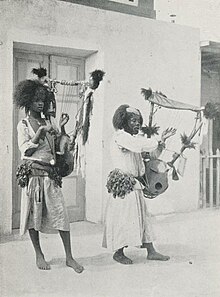Music of Sudan
Since the establishment of big cities like Khartoum as melting pots for people of diverse backgrounds, their cultural heritage and tastes have shaped numerous forms of modern popular music.[2] In the globalized world of today, the creation and consumption of music through satellite TV or on the Internet is a driving force for cultural change in Sudan, popular with local audiences as well as with Sudanese living abroad.Performances of songs, dance and instrumental music are used in rituals and social ceremonies like weddings, circumcision rites or to accompany the long camel treks of the Bedouins.[8] The music of Sudan also has a strong tradition of lyrical expression that uses oblique metaphors, speaks about love, the history of a tribe or the beauty of the country.One of the most typical East African instruments, called tanbūra or kissar in Nubian music,[10] was traditionally played by the singers as the usual accompaniment for such songs, but this Sudanese lyre has largely been replaced in the 20th century by the Arabic oud.[13] The History of the World in 100 Objects features a large wooden slit drum in the shape of a buffalo from southern Sudan, probably made in the 19th century for traditional performances in larger ensembles or to summon warriors, that is now held in the British Museum in London.She describes the common traits of these bards from the Zaghawa ethnic group like this:[16] "Free vocal rhythm and simple meter throughout, undulating and generally descending solo melodies ranging within an octave, great importance given to meaningful text, a syllabic setting of text to tone level, and a generally relaxed and thoughtful performance of songs – these are the traits present in the repertories of Zaghawi female bards and non-specialist singers.She must be acknowledged as the most clever and witty singer; often she must embody the idea of physical attraction, and particularly she must have the gift of poetry and improvisation, all this encompassed in a person of dignified bearing.[20][21] The numerous brotherhoods of Sufi dervishes in Sudan are religious, mystical groups that use prayers, music and ritual dance to achieve an altered state of consciousness in an Islamic tradition called zikr (remembrance).Already during the Turkish-Egyptian rule and later during the Anglo-Egyptian condominium until independence, first Egyptian, and then British military bands left their mark, especially through the musical training of Sudanese soldiers and by introducing Western brass instruments.[25] According to social historian Ahmad Sikainga, "Sudanese members of military bands can be regarded as the first professional musicians, taking the lead in the process of modernization and indigenisation.During his childhood years at a religious school, called khalwa in Sudan, Wad El Faki had learned recitation in classical Arabic, voice control and correct pronunciation."[9] Hageeba started as essentially vocal music, sung by a lead singer and a chorus, with percussion coming from the tambourine-like tar frame drum.[31] The pioneers of this era were often singer-songwriters, including the prolific Abdallah Abdel Karim, called Karouma,[32] the innovative Ibrahim al-Abadi and Khalil Farah,[33] a poet and singer, who wrote the lyrics and music for the patriotic song Azza fi Hawak and was active in the Sudanese national movement.After his beginnings in Sudan as a self-taught rock musician, he later turned to classical music and composed symphonic works of Sudanese or Egyptian inspiration that have been performed internationally.After a military coup in 1989, the imposition of sharia law by an Islamist government brought about the closing of music halls and outdoor concerts, as well as many other restrictions for musicians and their audiences.[64] Foreign musicians, who became popular in Sudan, included reggae superstar Bob Marley and American pop singer Michael Jackson, while the funk of James Brown inspired Sudanese performers such as Kamal Keila.[67] Ever since the third Sudanese Revolution started in December 2018, musicians, poets and visual artists have been playing an important part in the mainly youth driven movement.[70][71] According to Sudanese blogger Ola Diab, "young urban musicians have used their musical talents and creativity to express the revolt of protesters against President Al Bashir and his regime."[72][73] As in other countries, reggae, rap or hip hop music combines local talents and international, young audiences, both in live performances as well as on the internet.[75] International artists, such as the popular Australian hip hop musician Bangs, who was born in Juba, South Sudan, see these genres as an avenue for peace, tolerance, and community for millions of African youth, who are powerful in numbers but politically marginalised.[76] Jimmie Briggs, the author of the book Innocence Lost: When Child Soldiers Go to War (2005) concurred: "A music group is not an army, but it can get powerful social messages out before trouble starts.After leaving this band, one of their lead singers, composer and keyboard player Hiba Elgizouli has been pursuing her own career as a singer-songwriter and produced her own music videos.It was described in the following way by cultural journalist and fellow of the Rift Valley Institute, Magdi el Gizouli:This bootleg musical genre, pioneered by the King Ayman al-Rubo, is a fusion of West African beats and Egyptian mahrajanat style, with frequent accelerations and deceleration and techno-style repetition.









ArchitectureCinemaDecorationsHorsesLanguagesLiteratureMarriagePhotographyReligionTelevisionMohammed al AminArabicWesternAfricanurban musicKhartoumcultural heritageglobalized worldSouth Sudanspread of Islamindigenousown African languageSudanese version of ArabicChristianIslamic culturesArabian PeninsulaAfrican popular musicStandard ArabicSub-Saharan African music traditionsregionsethnic groupsMusic in AfricareligiousritualsceremoniescircumcisionBedouinsethnomusicologistspentatonicpolyrhythmstanbūrakissarhand clappingxylophonesBerta peopleBlue Nile stateThe History of the World in 100 Objectsslit drumBritish Museumkettle drumMahdist forcesBattle of OmdurmanDarfurZaghawaoral poetrypraiseridiculewestern Sudanincitevilifypeacebuildingconflict resolutionenvironmental protectionexorcisedervishesaltered state of consciousnessliturgyrecitationinstrumental accompaniment by drumscostumesincenseecstasytranceOmdurmanTurkish-Egyptian ruleAnglo-Egyptian condominiumbrass instrumentsindigenisationNational AnthemIndependence Day78-rpm gramophone recordAbdel Karim Karoumafolk songsprophet Muhammadmadeehreligious schoolkhalwaclassical ArabictambourineKhalil Farahgreater KhartoumGordon Memorial Collegepraise singingWhite Niledifficulties of female lifeIbrahim al Kashifaccordionbongo drumsbig bandstring sectionWesternisationCongolesesoukousCuban Rumbasuperstarsmilitary coup in 1989Sayed KhalifaMostafa Sid AhmedlyricsAzhari Mohamed AliMahjoub SharifSharhabil AhmedAli Nur ElgalilZakia Abdul Gassim Abu BakrAl BalabilAisha al FalatiyaHawa Al-TagtagalegitimacyHanan Bulu BuluAfrican-American musicbrass bandsmilitary recruitsAbdel Gadir SalimAbdel Aziz El Mubarakre-issueremastered